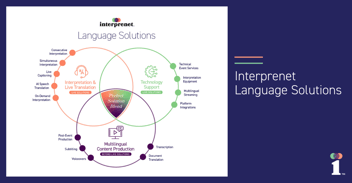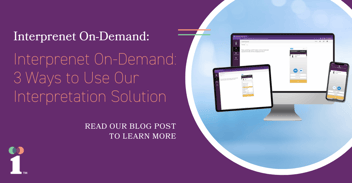
Hosting a multilingual live event can be a daunting task for professional conference planners. With participants and speakers from diverse linguistic backgrounds, it is crucial to ensure effective communication and a seamless experience for all event attendees. To achieve this, working with a full-service language service provider is imperative.
In this blog post, we will discuss five essential tips for hosting a flawless multilingual event, emphasizing the importance of partnering with a language service provider that offers comprehensive language solutions, technical support, and high-quality services customized to your specific needs.
1. Choose a full-service language service provider.
When organizing a multilingual event, it is vital to collaborate with a language service provider that offers comprehensive language solutions. A full-service provider like Interprenet can assist with interpretation services, live captions, AI Speech Translation, and more. By having all language-related services under one umbrella, you can ensure a streamlined process and consistent quality throughout the event.
2. Customized language services
Each multilingual event is unique, and it's important to work with a language service provider that can tailor their language solutions to your specific needs. Whether you require simultaneous interpretation, consecutive interpretation, or an AI-powered language solution, a full-service provider should be able to offer a customized approach based on your event's requirements, schedule, location, and technical setup.
3. Look for technical event services.
Hosting a multilingual live event often involves sophisticated technical setups. It's crucial to partner with a language service provider that not only offers language services but also provides technical support. From setting up interpretation booths to integrating remote interpretating solutions or live captions, having technical expertise readily available ensures smooth communication throughout the event. At Interprenet, we provide concierge-level technical support at the venue or remotely before and during your live event.
4. Top-quality interpretation equipment
Consider a language service provider that also offers interpreting equipment rental. The best interpretation is only as good as the sound quality and reliability of the audio transmission. That's why we offer top-quality rental interpretation equipment to cover your simultaneous and consecutive interpreting needs. By opting for a language service provider that also provides state-of-the-art equipment, you can simplify the planning process and avoid potential technical issues.
5. Ensure quality and accuracy
When it comes to multilingual events, accuracy and precision of communication are of utmost importance. Make sure that the language service provider you choose has a stringent quality control process in place to ensure the accuracy of interpretations and translations. Experienced professional interpreters and translators with subject matter expertise will play a significant role in delivering high-quality language services. At Interprenet, our linguists are carefully selected, qualified, and specialized.
Hosting a live multilingual event requires meticulous planning and attention to detail. By partnering with a full-service language service provider that offers tailored language solutions, technical support, and reliable quality, professional conference planners can ensure a flawless and inclusive experience for all attendees. Remember to prioritize accuracy, exceptional service, and customizable solutions when selecting the right language service provider. With the right team of language experts and technical support, your multilingual event is bound to be a resounding success.
Key Language Terminology
Below you’ll find a list of frequently used terms and acronyms in the language services industry. The list is sorted alphabetically. You may also download this glossary as a PDF for your convenience or share it with a colleague.
Accessibility: The practice of making information, activities, and/or environments sensible, meaningful, and usable for as many people as possible. Unlike usability, accessibility focuses on people with disabilities; for example, live captions help people with hearing difficulties.
AI Captions: Through proprietary Automated Speech Recognition (ASR) and machine engine learning, we caption our interpreters' live audio and stream it as real-time captions during your event.
AI Glossary: An AI Glossary enhances the accuracy of live captions and AI Speech Translation by pre-loading the system with specific names, brand names, technical terms, or product names.
American Sign Language (ASL) Interpretation: We provide competent interpreting services between individuals who are deaf and use ASL as their primary means of communication and individuals who are not deaf and do not know sign language.
Audience Headset Receivers: Worn by the audience members who need to hear the interpretation of a presentation or speech. Delegates listen in to the interpretation through headphones plugged into their wireless receivers.
AI Speech Translation (AIST): AI speech translation is a technology that uses artificial intelligence to automatically translate spoken language from one language to another. It combines speech recognition, machine translation, and speech synthesis to convert spoken words into another language in real time. At Interprenet, we offer AI speech translation to improve language access where an interpreter would otherwise be cost-prohibitive or unavailable.
Automatic Speech Recognition (ASR): Cloud-based software recognizes what is said in a language and converts it into text.
Certified Court Interpreter (CCI): Court certification is the highest level of state accreditation for judiciary interpreters. Sworn to adhere to stringent ethical and professional standards, our certified court interpreters are uniquely qualified to interpret accurately during criminal and civil legal proceedings.
Certified Medical Interpreter (CMI): Certified medical interpreters are trained to interpret during medical appointments or in other medical settings. They hold relevant national certifications and bring at least 3 years of experience in consecutive interpretation.
Computer-assisted Interpretation (CAI): A novel way for interpreters to receive real-time interpretation assistance related to technical terminology, acronym identification, and clarification of proper names.
Consecutive Interpretation (CI): The process of interpreting what is said in one language into another language, after it is said. Consecutive interpretation is ideal for back-and-forth meetings and dialogue settings.
Floor language: In the world of interpretation, the "floor language" refers to the original language that the speaker is using. It's the uninterpreted speech that the interpreter needs to listen to and convert into another language.
HIPAA: Health Insurance Portability and Accountability Act (relevant for healthcare interpreting in the US)
Infrared Emitters: Infrared emitters are hung on trusses or raised on tripods to ensure that infrared signals can be evenly distributed throughout the venue and attendees can hear the interpretation on their infrared headset device.
Intelligent Translation: Our intelligent translation process combines human skill and technological innovation to ensure your message is precisely communicated in another language to capture linguistic nuances and cultural subtleties.
Interpreter Booth: Soundproof booths for interpreters are used to avoid noise interference. By hearing the speaker only, the interpreters are not distracted by ambient noise, and their interpretation is only heard by the audience it is intended for.
Interpreter Hard Console: An interpreter hard console is a physical system used by interpreters to listen to one or different audio language inputs and speak the interpretation into a microphone. This microphone is connected to control units and transmitters to transmit the interpretation to people with interpretation receivers.
Interpreter Soft Console: An interpreter soft console is a cloud-based platform that brings remote conference interpreters into your meetings and events anywhere. The interpreter soft console we use is provided by our technology partner Interprefy. It is functionally tailored to the interpreters' specific needs, empowering them to deliver quality interpretation consistently.
ISO 27001-certified: The International Standard for Information Security. It sets out the specification for an information security management system (ISMS). Secures the confidentiality, integrity, and availability of corporate information assets.
Limited English Proficiency (LEP): Individuals who do not speak English as their primary language and have a limited ability to read, speak, write, or understand English.
Live Captioning: Live captions provide event or meeting attendees with a visual aid to follow and comprehend spoken content from anywhere. Interprenet delivers world-class multi-language captioning, assisted by AI or provided by a trained human captioner.
Localization (L10n): The process of adapting a translation to a specific country or region. For example, using common local terms and leveraging local customs, slang, and idioms to foster deeper understanding and connection through language.
LSP: Language Services Provider
Machine Translation (MT): Machine translation refers to the automated process of translating text from one language to another using computer software or algorithms.
Machine Translation Post-Editing (MTPE): The process by which a translator or a linguist reviews a translation generated by a machine and then corrects it to convert it into optimal publishing material.
Multilingual Subtitles: The most accurate translation solution for all your recorded audio-visual content. Studies have shown that younger viewers prefer to watch content with subtitles. And 50% of Americans watch content with subtitles most of the time, according to another study.
Multilingual Transcripts: The conversion of recorded audio or video content into accurate written text in over 300 languages. From keynote speeches to interviews to corporate meetings, we provide high-quality, edited transcripts in any language and for any format.
Neural Machine Translation (NMT): Text is automatically translated into the target language through specialized machine translation platforms that are customizable and adaptive or self-learning.
On-Demand Interpretation: Over-the-Phone Interpretation and Video Remote Interpretation are considered on-demand interpretation modalities as the interpreter can be requested at a moment's notice. With Interprenet On-Demand, our clients have access to over 13,000 qualified interpreters speaking 300 languages at the touch of a button.
Onsite Simultaneous Interpretation (OSI): Onsite Simultaneous Interpretation is the setup when an interpreter is on location, in an enclosed interpretation booth interpreting in real time to an audience listening on headsets or on their smartphones. This setup requires extensive professional installation and management of specialized equipment to ensure a seamless interpretation service.
Over-the-Phone Interpretation (OPI): Over-the-Phone Interpretation provides end users with high-quality interpretation instantly via a mobile phone or landline phone. With Interprenet On-Demand, our clients get connected to a professional interpreter on their phone in seconds.
Portable Interpretation Equipment: For walking tours or study tours that are constantly on the move, interpreters use small portable transmitters with small overhead microphones to transmit to attendees wearing headsets.
Recorded Interpretation Overlay: A recorded interpretation overlay is a technique used in video production where a pre-recorded interpretation is added over the original audio track of a video. This way, additional information can be provided to viewers of other languages without replacing the original audio completely.
Remote Simultaneous Interpretation (RSI): Remote Simultaneous Interpreting (RSI) mirrors Onsite Simultaneous Interpreting (OSI) for end users but stands out in its remote capability via a secure cloud platform. Meeting planners find RSI suitable for in-person and virtual events, with pricing potentially 50% lower than traditional onsite interpreting due to eliminating travel, accommodation, and soundproof booth costs.
Simultaneous Interpretation (SI): Simultaneous interpretation is the process of interpreting what is said from one language into another while it is being said. Simultaneous interpretation is often used for virtual and in-person events, such as large conferences, conventions, seminars, panel discussions, and press conferences.
Source Language: The source language is the language being translated from.
TOP ACT: Refers to Interprenet’s guiding principles and values. TOP stands for Total Commitment, Operational Excellence, and Problem Resolution. ACT is short for Accuracy, Creativity, and Trust.
Tabletop Interpreter Booth: Placed on a table, surrounding the interpreter on most sides, this booth only provides partial sound isolation. It is recommended for smaller audiences or tighter spaces.
Target Language: The language being translated or interpreted into, also called the receptor language.
Transcreation: Transcreation is a term coined from the two words "translation" and "creation." It is a concept used to describe the process of adapting a message from one language to another while maintaining its intent, style, tone, and context.
Translation Management System (TMS): A software platform designed to streamline and optimize the process of managing and coordinating translation projects. At Interprenet, our TMS conforms to the latest ISO security standards to protect the privacy of your data.
Translation Memory (TM): A database that stores previously translated sentences, paragraphs, or sentence-like units in blocks that are used to help human translators.
Transmitter: The interpreter translates what is said simultaneously into the target language. A Radio Frequency (RF) or IR (Infrared) transmitter instantly sends the signal to the digital headset receivers in the room.
Video Remote Interpretation (VRI): Video Remote Interpretation provides end users with virtual, on-demand interpretation via video. With Interprenet On-Demand, our clients get connected to a professional interpreter in seconds via desktop, tablet, or mobile.
Voiceover (VO): A professional voiceover (VO) actor is selected to record the voiceover on a previously produced video based on the client's target language, accent, demographics, and lip sync requirements.
Whispered Interpretation or Chuchotage: In whispered interpretation or Chuchotage, the interpreter provides interpretation simultaneously to a small audience of less than four people. In this setting, the interpreter is located close to the audience and whispers the interpretation into their ears. This is often used in bilateral meetings and small settings.



